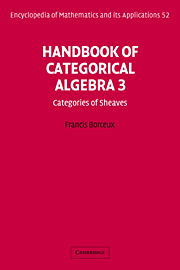5 - Elementary toposes
Published online by Cambridge University Press: 04 February 2010
Summary
Just as abelian categories are the categorical framework for studying those structures which behave like abelian groups, toposes are the categorical framework for studying those structures which behave like sets.
There are numerous equivalent definitions of the notion of a topos. We have chosen the most popular one, which is also the easiest one to handle in applications. An alternative definition is presented in the exercises.
In this first chapter devoted to elementary toposes – which we shall just call “toposes” – we focus our attention on their completeness and exactness properties. We prove the various results by purely categorical methods.
Our next chapter will be devoted to interpreting several exactness properties of toposes in terms of the “internal logic” of toposes. An alternative approach would have been to introduce first the internal logic of toposes and use it to prove the exactness properties. Logicians would probably prefer this latter approach, while category theorists often prefer ours.
We pay good attention to examples and show in particular, from the very beginning, that Grothendieck toposes are elementary toposes. But to illustrate the various notions we study, we give special emphasis to three examples which are fairly representative of the various characteristics which can appear in a topos:
the topos of sets, where the situation is “classical”;
the topos of sheaves on a locale, where elements exist at various levels and can be glued or restricted to produce elements at other levels;
[…]
Information
- Type
- Chapter
- Information
- Handbook of Categorical Algebra , pp. 288 - 341Publisher: Cambridge University PressPrint publication year: 1994
